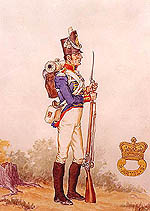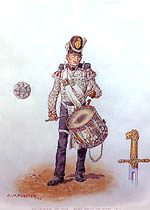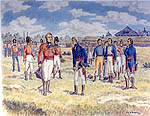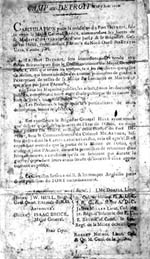Norton describes the surrender of Detroit
(from the Journal of Major John Norton, p. 300 - 301)
... The next morning General Brock arrived with a considerable detachment of the 41st and militia dressed in red coats. He commenced by sending a summons to
General Hull to demand the surrender of his army and the place he held - the flag soon returned with a refusal. A battery opposite to Detroit, which had already been begun, was soon completed, and in the evening a few shots were fired to try the effect, which were returned with great punctilio: -- the distance across the river at this place was something more than a thousand yards.
It was arranged to cross before the dawn of day. The armed vessels moved up the river to cooperate. General Brock made selection of our party to accompany the troops: the warriors from Amherstburg led by
Stauegtha [Roundhead], Tecumthi [Tecumseh], Tharoutorea and Mei ire were to pass in the skirts of the wood, & to take the enemy in flank, should he come out to give us battle. In the morning we crossed at La Belle Fontaine. There had been usually a piquet [guard] at that place, of about one hundred men, -- but we found none there.
|

Soldier of the Royal Artillery |

Drummer boy |
The breadth of the river as well as the scarcity of boats, -- caused us some delay, ere we were in readiness to advance. All formed, -- we proceeded; -- the troops followed in good order, -- so as to give the whole body the appearance of regulars. Our gallant General rode in front of them. The cannon from our batteries were firing at the fort, the enemy making regular answer. When we had approached near I proposed to the General that with my party I might incline to the left, to examine some enclosures and a ravine that might conceal an ambuscade. He approved the plan, cautioning us to avoid precipitation in the most affectionate manner.
|
Passing the ravine; we found assembled in it a number of females & children of the French Canadian inhabitants - who had taken shelter there, from the probable fire of the expected conflict. When we came within a hundred and fifty yards of McComb's enclosure we perceived the heads of the Americans behind the pickets, waiting to be joined by those following. The enemy retired precipitately - we ran to intercept some horsemen entering the fort - they escaped us, but in making this attempt, we came between the sentry and the camp, & took him prisoner; he belonged to the 4th Regiment, and appeared so much alarmed that it was with great difficulty we could get any information from him: I sent him to the General. The white flag was now hoisted, -- and we heard that the enemy had entered into a party to capitulate. The parapet of the fort was crowded with men - those in the camp outside of it, were striking the tents and removing everything precipitately, -- at the same time making pacific signs to prevent attack.
The capitulation was concluded: -- The American General agreed to surrender prisoners of war, (excepting only the militia, who were to be sent home immediately,) - and to deliver up the fort to the British troops at 12 o'clock. The arms surrendered of all kinds, might amount to between two and three thousand stands, but there was not more than one thousand regular troops. The force that General Brock led on consisted of about six hundred regulars and militia in red coats, and perhaps as many Indian warriors; -- the latter were increasing in number daily, -- in a few days more we would have exceeded a thousand.
The fort was taken possession of by a part of the 41st Regiment, -- and the General recommending us to go to
Amherstburg, we returned to Sandwich that evening, & the next morning went on to
Amherstburg. The Americans can have no pretence for accusing the Indian allies of cruelty in this instance.

The surrender of Detroit |
|
|

The text of the terms of the capitulation |



